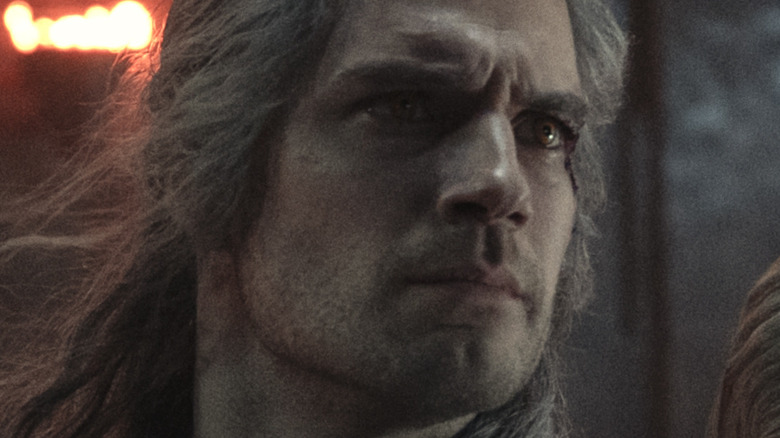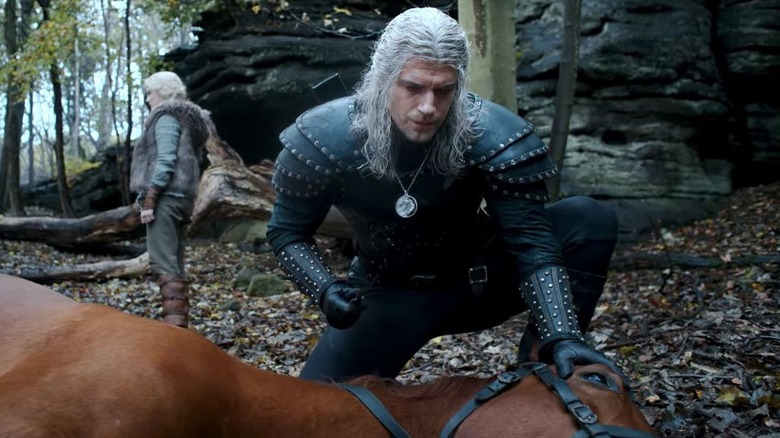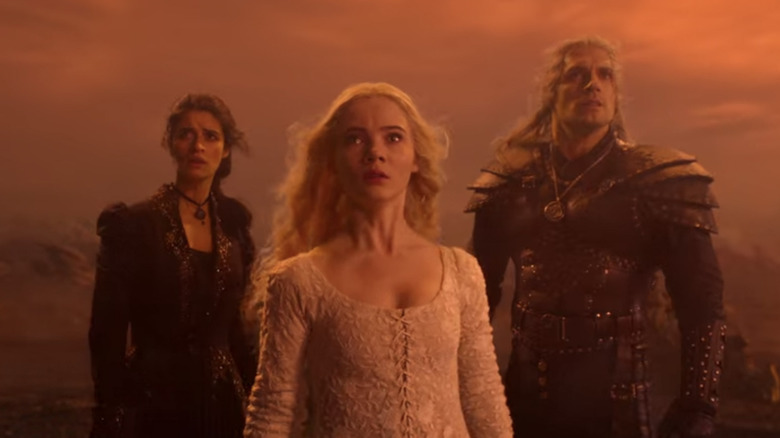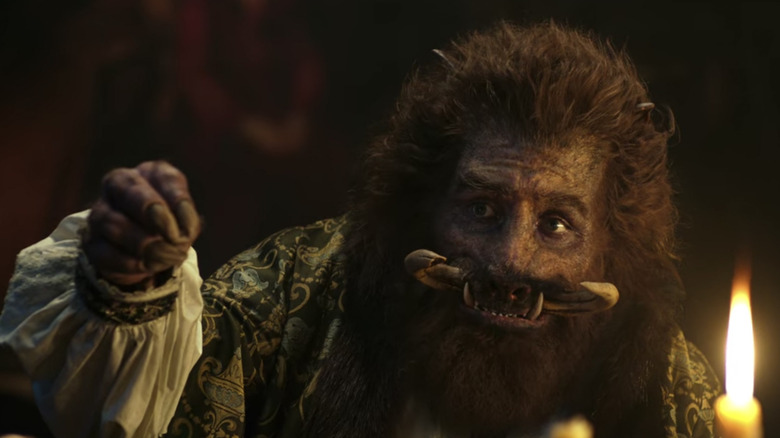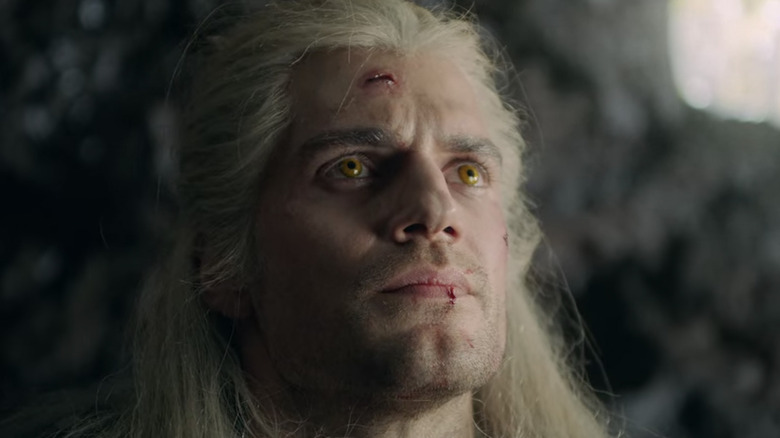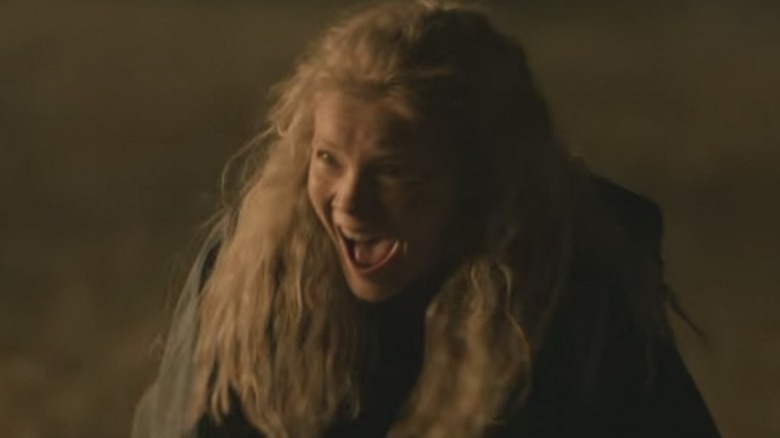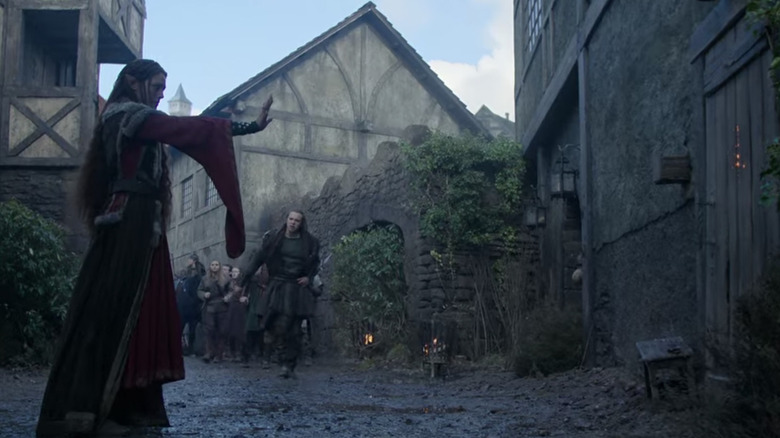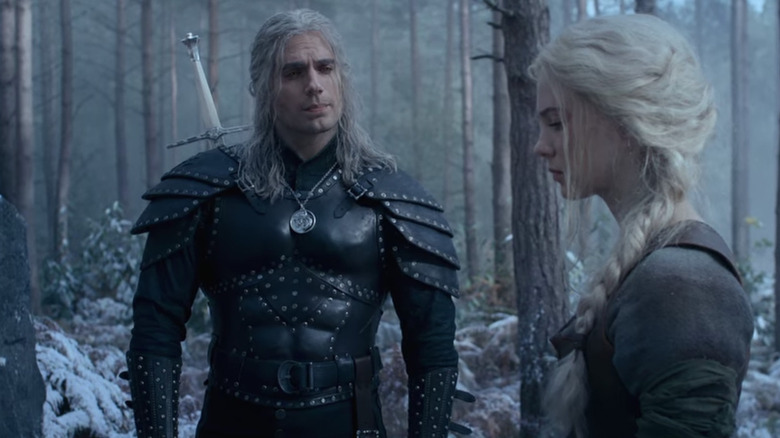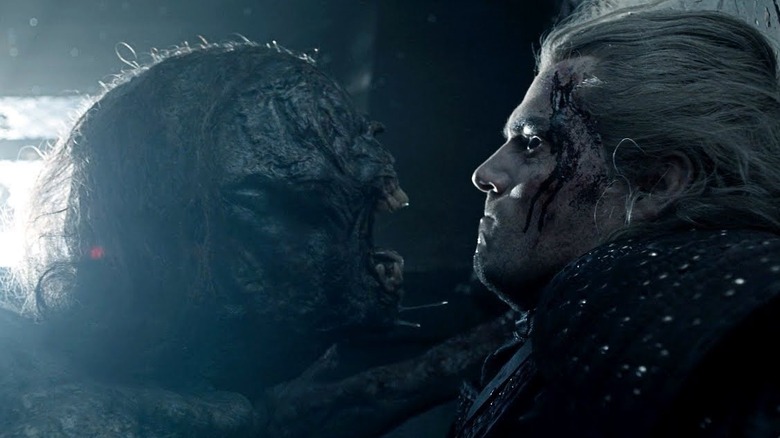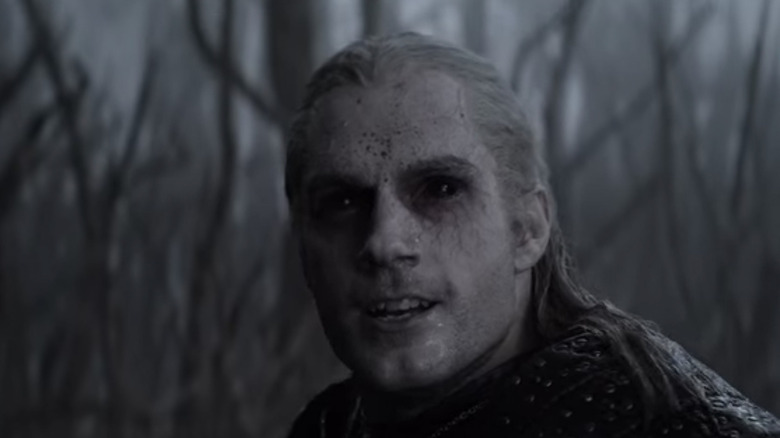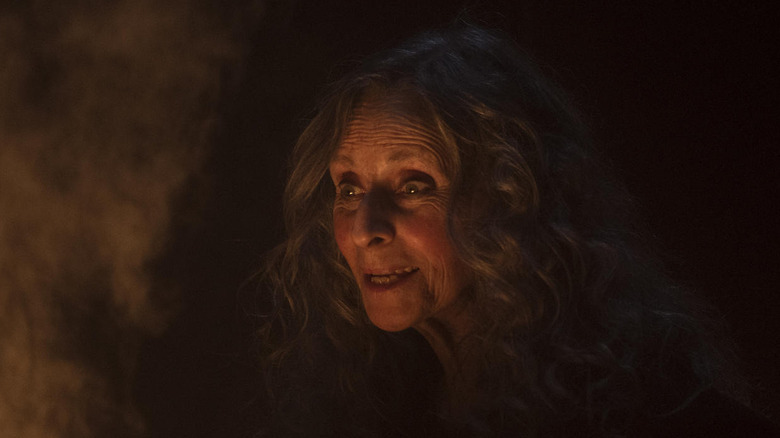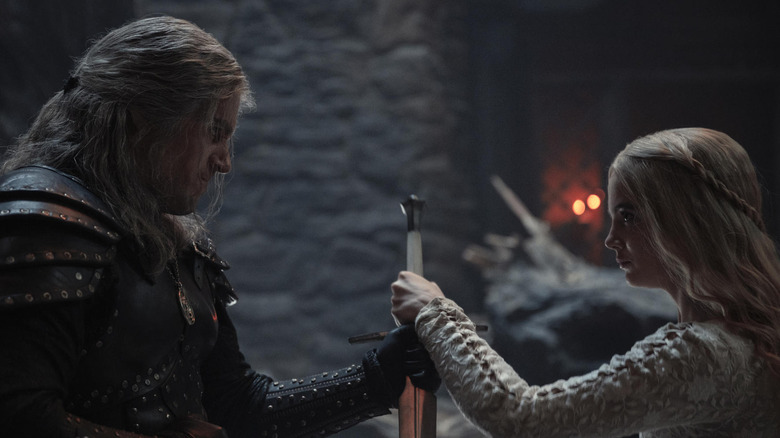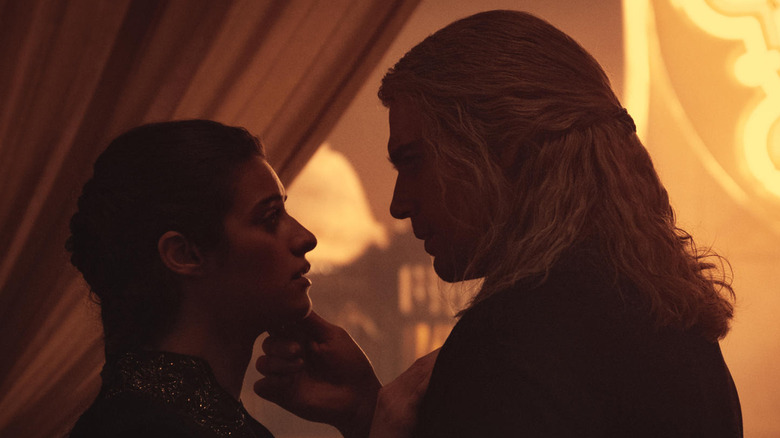The Witcher Scenes That Mean More Than You Think
Geralt of Rivia is a man with many secrets, a man who plays his Gwent cards close to his chest. It's fitting then that a show about Geralt maintains its own air of mystery. "The Witcher" did just that, keeping us guessing through some cheeky visual references, hidden quotations from the "Witcher" books, and overarching thematic questions.
Given Geralt's reticence, some viewers may have walked away from the latest season with a few questions. We invite those viewers to explore some scenes from the show that have a deeper thematic meaning than they may have thought on first viewing. But even viewers who felt totally confident after their watch will want to stick around for some behind-the-scenes trivia and breakdowns of Easter eggs in various scenes throughout the two seasons of "The Witcher."
For instance, did you catch the visual nod to a classic Disney movie when watching Season 2? Or that brief scene in the Season 2 finale with a Biblical allusion from Exodus? Even the keenest "Witcher" fans probably missed a secret or two, and who can blame them when Henry Cavill is there distracting them the whole time? But fret not, ye denizens of The Continent, for we have compiled all this hidden knowledge for you to pore over, maybe while taking a warm bath?
Special words for a special horse
Now who said Witchers were emotionless? Well, in the world of "The Witcher," this is a common misunderstanding about Geralt and the monster-slaying men of his ilk. Though sometimes they may seem aloof, deep down Witchers are real softies.
Take Roach for example. Every horse Geralt has ever had has been named Roach, producer Tomasz Bagiński explains in "Making The Witcher: Season 2." Maybe Geralt does it for simplicity's sake — that way he'll never forget the name. Maybe he reuses the moniker to remind himself that he and his horse are not special; they're no better than insects. Either way, it comes off as rather emotionless. But Bagiński insists that this "doesn't mean that [Geralt is] not emotionally connected with every horse he had."
This is the Witcher dichotomy: stoic but not heartless. Henry Cavill was actually the one who recognized this best, particularly in the scene in "Dear Friend..." where Roach dies. Showrunner Lauren Hissrich told Polygon that the script originally included a joke to cut the tension. But she remembers that "Henry was so unhappy with the line," so she allowed him to approach it however he wanted. Cavill chose a poetic line from one of the "Witcher" books, "Sword of Destiny," which lent the scene a more appropriate gravitas. As he ends Roach's suffering, Geralt recites these lines: "Enjoy your last walk across the meadow and through the mist. Be not afraid of her for she is your friend."
The Witcher family together at last
Much of Season 1 sees Geralt shirking his fatherly duty to Ciri, his child of surprise. By Season 2, he's shown up for Ciri, and it's clear how much he cares for her and how much she admires him. Still, this family picture is missing a crucial piece: the mother.
When Yennefer of Vengerberg finds Ciri and Geralt, the question of family comes up over and over again in those final episodes. Francesca, one of the leaders of the elves in Nilfgaard, chooses to settle down with her new family instead of helping Fringilla's war effort, citing the powerful bond of family. In response, Fringilla seeks out help from her uncle, a high-ranking mage, calling on that same familial bond. However, he only agrees to help if she humbles herself before the council of mages. Fans are left wondering: should family permit you to forsake your duty? Should family humiliate you when you ask for help?
In the last scene of the finale's battle, a better image of family is presented in place of Francesca and Frigilla's examples. Here, Yennefer sacrifices herself to save Ciri, who has become possessed by a witch. Once freed, Ciri transports herself, Yen, and Geralt to a different world, where the three stand united against the Wild Hunt, before escaping at the last moment. While this new union is complicated – given Yen's betrayal and kidnapping of Ciri — it's the first time the Witcher family portrait has felt complete.
A tale as old as time
The Season 2 premier of "The Witcher" demonstrated outright that Disney's "Beauty and the Beast" live-action reboot wasn't gritty enough. The show's writers and, especially, cinematographer Romain Lacourbas took it upon themselves to correct that in "A Grain of Truth."
It begins with Geralt and Ciri arriving at a gloomy manor in a disturbingly quiet hamlet. This is the home of Geralt's old friend Nivellen, who has been transformed into a lion-spider hybrid through a mysterious curse. Though it takes a moment for it all to click, the episode clearly parallels "Beauty and the Beast." For instance, a Vulture recap points out how Nivellen "conjure[s] up an impressive feast" in the spirit of "Be Our Guest." It's more of an allusion than a direct reference, but the connection isn't illusory. As cinematographer Lacourbas explains in a Looper exclusive, "'Beauty and the Beast' was on my mood board" for the episode.
In "The Witcher," though, no beauty is ever fully pure, and no beast entirely monstrous. The Disney allusion suggests there will be a happily-ever-after moment at the climax, but in the episode's final battle, Nivellen's beauty is revealed to be a horrifying Bruxa. After Geralt slays it, Nivellen returns to his human form, only to confess the horrific origin of his curse. Without spoiling too much, the scene successfully inverts the old Disney trope. The beauty is a monster, tragically slain; the beast is human again, but he's never seemed more monstrous.
Scenes of monsters and men
Before the Bruxa is slain, she and Ciri have a heart-to-heart about the nature of monsters. This conversation elaborates upon what is arguably the central thematic question of the series: what is it that separates monsters from men?
The Bruxa awakes Ciri from her sleep, but does not harm her. She tells Ciri that she recognizes a similarity within Ciri; they are alike. "Are you a monster because you are different?" the Bruxa asks. "Monsters do bad things to people," Ciri says. "Humans do bad things to everybody," the Bruxa replies. This interplay between strangely kind monsters and brutal humans is portrayed in all its complexity in the final scene, where Nivellen becomes human again.
But the conversation between Ciri and the Bruxa shares some notable similarities with a scene from the second episode of Season 1. Geralt and Jaskier are captured by elves, and Geralt has a heated conversation with the elven leader. Geralt tells him that the elves need to stop hiding away from humans and "show [them] you are more than what they fear you to be." Just as the leader is about to execute the Witcher and the bard, a sylvan that Geralt spared earlier begs the leader to stay his blade. "He's different," the sylvan says about Geralt, "Like us."
Imagine a Venn diagram with monsters on one end and humans on the other. Ciri and Geralt sit in the overlap between the two extremes, but scenes like these bring into question the entire distinction.
Ciri and Yen's 'conduit moments'
In "The Witcher: A Look Inside the Episodes," showrunner Lauren Hissrich detailed the concept of "conduit moments" in Episode 2. These moments are meant "to explore how" the witches and sorcerers of "The Witcher" first "learnt that they had magical powers." The most significant conduit moments in the show, as of yet, are the scenes in Season 1 where Yennefer and Ciri discover their magical potential.
Yen's conduit moment occurs in Episode 2 of Season 1. While getting accosted by a couple in her village, Yen closes her eyes, struggles, and suddenly she's somewhere else. Here she meets Istredd, a mage who explains to Yen that the teleportation will put "a target on [her] back." Yen's conduit moment teaches her, for the first time in her life, that someone can be admired for a raw talent within herself. It also begins two powerful, complicated relationships: Yen's semi-romantic relationship with Istredd and her difficult mother-daughter relationship with Tissaia, who targets Yen for her magic.
Ciri's conduit moment, while less uplifting, has Continent-ending implications, as is revealed in Season 2. The moment itself occurs at the end of the Season 1 premiere. Channeling the power of her Elder Blood into a scream, Ciri is able to escape capture, destroying an obsidian-like monolith in the process. These monoliths are themselves conduits that connect to other realms, and they act as portals for horrible new monsters to travel through in Season 2.
Elven Passover
It may not seem obvious at first that the elves in "The Witcher" are like the enslaved Israelites in the Book of Exodus. But for those biblical scholars who enjoy high fantasy, the connection became clear in the scene in Episode 8, "Family," where Francesca casts a horrific curse over the infants of Redania.
Francesca, an elven leader, travels to Redania to avenge the murder of her newborn child. Once there, she casts a spell that burns a sigil into different doorways throughout the city. That same sigil is then seen burned onto the chests of infants inside the marked houses. She swings her arms in a final chant, and the newborns all die. In Exodus 11, God tells Moses that "all the firstborn in the land of Egypt shall die," a punishment inflicted in order to help the Israelites escape slavery in Egypt (per BibleGateway). God distinguishes between firstborn Egyptians and firstborn Israelites, in Exodus 12, by commanding the Israelites to paint their doors with lamb's blood. When death passes through Egypt, it will pass over (hence the name of the Jewish holiday) the bloodied doors of the Israelites.
The dark reversal here is that Francesca's sigil represents not the elves' salvation, as it did for the Israelites. Instead, it more accurately represents the deception enacted against them by the Nilfgaardian emperor, and will only further entangle them in the violence spreading across The Continent.
Geralt gets new threads
Kaer Morhen isn't just good for finding Witchers and whiling away the winter — it's also the hot spot to pick up the latest fashion piece. For Geralt, that piece is a bit retro, at least according to Henry Cavill. In "Making The Witcher: Season 2," Cavill explains that Geralt "hasn't had the opportunity to stop anywhere, buy armor or make it, so he delved into the dungeons of Kaer Morhen and found something very old, from a different era."
This new armor is all black and studded, with shoulder plates that overlap like an armadillo's carapace. The new chestplate accentuates Cavill's physique (even including faux abs), and overall it makes Geralt look like a total badass. The inspiration for the armor may stem from the video games, according to a fan on Reddit, who compared it to the School of the Bear armor from the third "Witcher" game (per IGN).
Inspiration and narrative justification aside, showrunner Hissrich admitted in "Making The Witcher" that the primary reason for the new costume was a practical one. Early in filming for Season 1, it became apparent that Geralt's armor, while beautiful, "restricted [Cavill's] movement" and was "incredibly complicated to get on and off." According to Cavill, the new costume was "a lot easier to fight in." This decision, while more practical than thematic, allowed every fight scene in Season 2 to better reflect the fluid and dynamic combat for which "The Witcher" games were known.
Geralt's second chance to save the princess
Geralt has something of a white knight streak. Even when he's going against his own best judgment, he can't help himself from trying to protect others. This is a tendency that the showrunner, Lauren Hissrich, returns to again and again in "The Witcher: A Look Inside the Episodes."
What is a white knight known for if not trying to save the princess? In the series premiere, however, Geralt fails to do just that. A cursed princess, Renfri, seeks revenge against a mage in the town of Blaviken. Geralt gets caught up in the mix, and after killing Renfri to save a girl, he's left wondering, according to Hissrich, "if he did the right thing."
Two episodes later, Geralt encounters a situation much like the first: a cursed princess is wreaking havoc upon a kingdom. Much like with Renfri, this princess — turned into a monstrous Striga — did not choose the curse that has befallen her. This time, Geralt "does not want to kill another princess," Hissrich explains, and "this episode ... provides a chance to do it all over again and to make a different decision," in this case the choice to lift the princess' curse.
Here, "The Witcher" asks again: what makes a monster? In "Betrayer Moon," as Geralt hides from the Striga, bloodied but refusing to deal the killing blow, he proves — to himself if nobody else — that Witchers are not as monstrous or emotionless as they have been made out to be.
Witchers have hearts after all
Where did Witchers get these nasty associations anyway? In the show, at least, they were intended from the very first scene. Lauren Hissrich says in "Making The Witcher" that in the opening of the series premiere, wherein Geralt battles with a Kikimora, she wanted him to appear terrifying. With all-black eyes and dark monster blood dripping off him, Hissrich says that we "see him almost as a monster himself." This fearsome demeanor and skill with a sword may explain why they are, as Hissrich says, "so hated and feared by people."
But Geralt is not a monster; he's a hero. His character arc in Season 1 concludes with an affirmation of his humanity and protective instinct. While heading back to Kaer Morhen in the season finale, Geralt comes upon a man tending to some corpses. When Ghouls attack the man, Hissrich says that "Geralt, despite his desire not to get involved, constantly gets involved in everything," saving the man but getting fatally injured in the process. This scene itself suffices to show that Geralt is not emotionless nor monstrous, but the subsequent dream sequence best demonstrates Geralt's heroic core.
While under the effects of the Ghoul bite, Geralt dreams that he is "talking to his mother ... about being a white knight," Hissrich explains. She hopes that this scene inspires audiences to rewatch the first season's episodes and realize that "actually he's been trying to be a white knight" all along.
Creatures with monstrous origins
"The Witcher" has enough monsters to fill up an entire bestiary. In fact, they did. Twice. The great thing about "Witcher" monsters is that the creators "like to go back into lore ... historical lore, mythological lore ... fairy tales ... to find real references for those monsters," as showrunner Hissrich attests in "Making The Witcher: Season 2." All of these monsters are carefully crafted, from the Leshy to the Chernobog, but one creature especially deserves a closer look.
The queen of monsters in Season 2 is Voleth Meir, the Deathless Mother. Despite her importance, she actually doesn't exist in the book that Season 2 is based upon. "There is a lot of exposition [in the book]," producer Tomasz Bagiński explains in "Making of The Witcher," so "we decided to introduce an overarching monster." Lauren Hissrich says Voleth Meir is based on the Baba Yaga, which "almost every culture has a version of." She is "a witch who lives in the woods ... lures people inside [her hut] and ... steals their souls."
Voleth Meir is introduced in the second episode of Season 2, wherein she asks Fringilla, Francesca, and Yennefer to make a wish. Much like the Djinn of Season 1, Episode 5, these wishes have unforeseen consequences, ones that aren't realized until the final episodes of the season. Once Voleth Meir's plan comes to fruition, however, it feels as if the three women are like Hansel and Gretel, lured into losing their souls.
Could Ciri be a Witcher?
Ciri takes to the Witcher life so easily, it seems as if she were born to be one. Given that she is Geralt's child by destiny, that may not be so far from the truth either. It's no surprise then that this question — whether Ciri will become a full-fledged Witcher — presents itself again and again throughout Season 2.
Freya Allen, who plays Ciri, sees her character's transformation in Season 2 as the choice to fight instead of always running from her problems. "You get to see that she is determined," Allen says in a Netflix interview, "because she would like to become a Witcher." In the climactic moment of the third episode, it seems Ciri may just do it, too, as she (almost) successfully completes the deadly Witcher obstacle course.
In the fifth episode, "Turn Your Back," Vesemir discovers that Ciri's blood holds the secret to creating the Witcher mutagen, a substance that turns ordinary humans into superhumans. Ciri agrees to let him use her blood, but only if he injects her with the first dose. Just as Vesemir is about to plunge the needle, Geralt intervenes. In this scene, Ciri reveals exactly why she wants to be a Witcher. "I want to be like you, Geralt," she says. "You are already enough, Cirilla," Geralt replies. "You are extraordinary."
So while Ciri does not end up a Witcher (at least not yet), the question is answered. According to Geralt, she doesn't need to be one.
The Easter eggs of Melitele
All monster hunting and no play makes Geralt a dull Witcher; that's probably why the writers made sure to sneak some Easter eggs in among the more dramatic scenes. The second of these is more tawdry than the first (so reader beware), and both occur in Episode 6, "Dear Friend..."
The first Easter egg is buried in the title itself. When Yennefer arrives at Melitele, she reunites with Geralt, and it's the first time the two have seen each other since Season 1. Thus it's comically underwhelming when Ciri walks in on their reunion and Geralt refers to Yen as his "dear friend." A Reddit user connected this line to a joke in the books. In a letter, Geralt addresses Yen by "dear friend," and in her reply, she mocks him by calling him "friend" seven times in only four short paragraphs.
The second in-joke comes a bit later in that same episode. When Ciri expresses doubt at the existence of unicorns, Yen says she used to have a "stuffed one" that "broke" under mysterious circumstances. While this line seems rather innocuous on the surface, fans of the "Witcher" books and video games will know precisely the "mysterious circumstances" Yen references. In the book "Sword of Destiny" as well as the third video game, Geralt and Yen make love atop this same stuffed unicorn. Conan O'Brien even made a joke about it in his "Clueless Gamer" segment.
After all that, he called her his "dear friend?" The gall of that Witcher...
